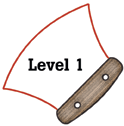
Alaska Science
Key Element A4
A student who meets the content standard should understand observable natural events such as tides, weather, seasons, and moon phases in terms of the structure and motion of the Earth (Earth).
 |
Alaska Science A student who meets the content standard should understand observable natural events such as tides, weather, seasons, and moon phases in terms of the structure and motion of the Earth (Earth). |
|
Performance Standard Level 1, Ages 5–7
|
|
|
|
Sample Assessment Ideas
|
|
|
Expanded Sample Assessment Idea
|
|
Procedure Students will:
Reflection and Revision
|
Levels of Performance |
||
|
Stage 4 |
Student work is complete and correct. Student uses appropriate terms in more than one language to describe the weather in detail. Student drawing, graph, and explanation are accurate and each shows evidence of higher-level thinking. Student explanation shows evidence of extension of knowledge through detailed predictions. | ||
|
Stage 3
|
Student work is generally correct, but may contain minor errors or omissions. Student uses appropriate terms in more than one language to describe the weather. Student drawing, graph, and explanation are accurate. Student’s prediction is correct, but may lack detail. | ||
|
Stage 2
|
Student attempts to use more than one language to describe the weather, although several of the terms may be incorrect or inappropriate. Student drawing, graph, or explanation may be incomplete, incorrect, or lack detail. Student work may contain misconceptions and errors of science fact and reasoning. | ||
|
Stage 1
|
Although the work may be on topic, the student uses incorrect terms in one or both languages to describe the weather. Student drawing, graph, and explanation are largely incomplete, incorrect, and show little or no evidence of understanding weather and weather patterns. | ||
Standards Cross-References
|
||
|
National Science Education Standards Weather changes from day to day and over the seasons. Weather can be described by measurable quantities, such as temperature, wind direction and speed, and precipitation. (Page 134) Objects in the sky have patterns of movement. The sun, for example, appears to move across the sky in the same way every day, but its path changes slowly over the seasons. The moon moves across the sky on a daily basis much like the sun. The observable shape of the moon changes from day to day in a cycle that lasts about a month. (Page 134) |
Benchmarks The moon looks a little different every day, but looks the same again about every four weeks. (Page 62) Some events in nature have a repeating pattern. The weather changes from day to day, but things such as temperature and rain (or snow) tend to be high, low, or medium in the same months every year. (Page 67) Water can be a liquid or a solid and can go back and forth from one form to the other. If water is turned into ice and then the ice is allowed to melt, the amount of water is the same as it was before freezing. (Page 67) Water left in an open container disappears, but water in a closed container does not disappear. (Page 67) |
|
Table of Contents | Return to Alaska Native Knowledge Network